The laptop we are reviewing today is the Lenovo YOGA Slim 7 Gen 8 (2023 model, YOGA Slim 7 14APU8), the latest model in the series with an upgraded processor. The laptop lies in the business segment of notebooks due to its sleek design and robust performance. It comes with a Ryzen 7 7840S processor, LPDDR5 RAM, and a range of other features. In addition, its portable form factor (thanks to its lightweight and slim body) makes it perfect for business travelers and on-the-go professionals who need reliability and versatility in their work equipment.
Specifications
| Screen | 14.5″ 3K (2944 x 1840), 90Hz, 16:10, OLED, 400 nits, 100% DCI-P3, Dolby Vision, TÜV Low Blue Light, Eyesafe |
| Processor | AMD Ryzen 7 7840S (Base frequency: 3.2GHz and Max Frequency: 5.1GHz) |
| Wireless Connection | WiFi 6E and Bluetooth 5.3 |
| Graphics card | Integrated AMD Radeon 780M |
| Memory | Up to 32GB LPDDR5X, dual channel, 6400 MHz (soldered on motherboard and non-upgradeable) |
| Storage | 1TB NVMe PCIe Gen4 SSD, 4x M.2 SSD slots |
| Camera | FHD webcam, IR camera + ToF, and Electronic Privacy shutter |
| Ports | 2x USB-C 4.0 (with USB PD 3.0 and DisplayPort 1.4) 1x USB-C 3.2 Gen 2 (with USB PD 3.0 and DisplayPort 1.4) 1x 3.5mm headphone Jack |
| Battery | 70Wh battery with 65W adapter |
| OS | Windows 11 Home Windows 11 Pro |
| Weight | 1.35 kg (2.98lbs) |
Appearance
The Lenovo YOGA Slim 7 Gen 8 looks very similar to its predecessor, but with one significant upgrade. It features an ultra-narrow bezel design with a 14.5-inch screen that boasts a 16:10 screen ratio, which increases the display area by 11% and provides users with a more expansive visual experience.
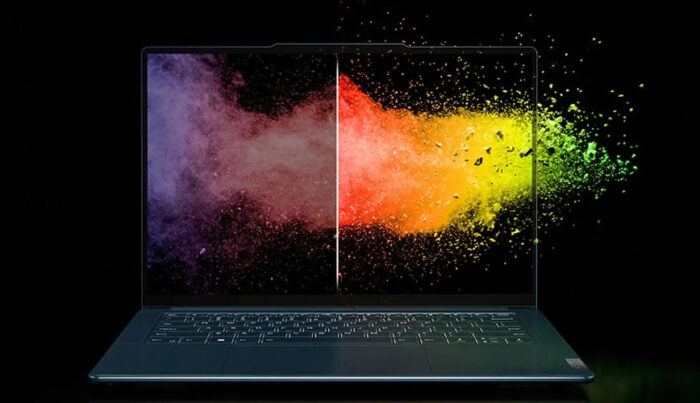
The dimensions of the Lenovo YOGA Slim 7 Gen 8 are 326 x 223 x 13.9 mm, and it weighs 1.28 kg. It is available in two body colors, including Misty Grey and Tidal Teal.
In short, the Lenovo YOGA Slim 7 Gen 8 combines a sleek design, a larger display, and shiny side finishes, all of which make it very lightweight and easy to carry. This laptop is designed to provide attractive visuals and a comfortable user experience to meet different computing needs.
Display
The Lenovo YOGA Slim 7 Gen8 comes with a 14.5-inch OLED screen. It supports a 2944×1840 resolution with a 16:10 aspect ratio and a brightness of 400 nits, allowing you to see everything clearly even in sunlight. Thanks to the 90Hz refresh rate, the screen is very smooth in use.
The 14.5-inch screen boasts several certifications, including Dolby Vision, HDR 500, EyeSafe 2.0, and TÜV Low Blue Light. Lenovo claims it has a 100% DCI-P3 color gamut, which will be confirmed during the display testing phase.
We tested the screen with Spyder X. The screen covers 100% of the sRGB color gamut, 93% of the Adobe RGB color gamut, 100% of the DCI-P3 color gamut, and 91% of the NTSC color gamut. It also reached a maximum brightness of 397 nits and a contrast ratio of 27,266:1. The average Delta E was just 0.61.
Screen Test Results |
|
| sRGB | 100% |
| Adobe RGB | 93% |
| DCI-P3 | 100% |
| NTSC | 91% |
| Maximum Brightness | 397 |
| Contrast Ratio | 27266:1 |
| Average Delta E | 0.61 |
| Minimum Delta E | 0.08 |
| Maximum Delta E | 1.58 |
The company has inserted an FHD webcam on the top bezel of the display. It also supports IR, E-shutter, and fixed focus.
Keyboard and ports
The Lenovo YOGA Slim 7 Gen 8 comes with a backlit keyboard. The keyboard is designed to provide unrivaled typing speed and accuracy. They offer 1.5mm key travel and good rebound, making it comfortable and efficient to use. And there’s no need to worry about spills. Thanks to a special coating, it’s designed to resist dirt and splashes.
The keyboard’s backlighting can be turned on automatically in low-light conditions. According to official claims, the keyboard is also eco-friendly as it is made of 50% recycled plastic.

The touchpad features a keyless glass surface and supports multi-touch gestures. Its size is so large that it allows you to move the cursor precisely across the screen with a single swipe of your finger.
On the right side of the laptop, there is a power button, a camera electronic control switch, and a USB 3.2 Gen 2 Type-C port. On the left side, there are two USB 4.0 Type-C ports. There is also a 3.5mm headphone jack.
It’s worth noting that due to space constraints and a focus on slimness, Lenovo has made compromises in terms of the number and types of ports available on the Lenovo YOGA Slim 7 Gen 8. Depending on their specific requirements, users may need to carry a USB dock to expand connectivity options.
RAM, SSD, and Network
The Lenovo YOGA Slim 7 Gen 8 comes with 32GB of LPDDR5x memory, which is soldered to the motherboard, so it is not upgradeable. It should be noted that this memory runs in dual-channel mode and runs at a clock speed of 6400 MHz. Lenovo offers two RAM configurations for this laptop: one with 16GB of RAM and the other with 32GB of RAM.
We also ran memory tests using the AIDA64 Memory and Cache benchmark application, and the results were as follows: a read speed of 50,708 MB/s, a write speed of 93,312 MB/s, and a copy speed of 69,198 MB/s. The latency rate was measured at 120.8 ns. The write speeds were impressive, but it’s worth noting that read speeds were relatively low.
The Lenovo YOGA Slim 7 Gen 8 comes with an M.2 2280 PCIe 4.0 SSD and has four M.2 slots. The version we tested came with a 1TB Samsung PM9A1 SSD (the OEM variant of the Samsung 980 Pro). After removing the back cover, we found that the manufacturer had applied thermal paste to the SSD, allowing the laptop’s metal bottom cover to act as a heat sink and reduce the heat generated by this component.
In the benchmark, we used the CrystalDiskMark benchmark application. The test results are as follows: 6651.72 MB/s sequential read, 4943.01 MB/s sequential write, 65.24 MB/s 4K read, and 105.89 MB/s 4K write. We also conducted a second test using the AS SSD Benchmark app, which gave the SSD an overall score of 4121. It has an impressive sequential read speed of 4506 MB/s and a write speed of 111 MB/s. Even 4K read and write speeds exceed 61 MB/s and 125 MB/s, respectively.
Battery and Charging
The Lenovo YOGA Slim 7 Gen 8 has a 70Wh battery, which is more than enough for a 14-inch laptop.
This battery is a Li-ion type with a capacity of 4522mAh. According to the official claims, the laptop can run for approximately 9.6 hours (at 200 nits brightness) in the MobileMark 2018 benchmark software. When playing a regular Full HD (1080p) video, you can expect an impressive 14 hours of playback time.
We also conducted a battery life test using PCMark 10 software. We enabled the energy-saving mode, turned off all other programs, turned off Wi-Fi, and adjusted the screen brightness to 50%. Under these conditions, the laptop provided an impressive battery life of 14 hours and 8 minutes.
The Lenovo YOGA Slim 7 Gen8 also comes with a 65W USB-C slim AC adapter, which supports PD 3.0. This charger can charge your phone. According to Lenovo, a quick 15-minute charge can provide an additional 2 hours of battery life for your laptop. But keep in mind that this fast charging only works when your laptop is in hibernation mode or completely turned off.
CPU Benchmark
The Lenovo YOGA Slim 7 Gen8 comes with an AMD Ryzen 7 7840S processor. The processor uses TSMC’s 4nm manufacturing process and consists of 8 cores and 16 threads, which means it can handle multiple tasks simultaneously. The CPU runs at a base frequency of 3.3 GHz and can reach a maximum frequency of 5.1 GHz when needed. It features an 8MB L2 cache and a 16MB L3 cache. The CPU also has an integrated Radeon 780M GPU.
The Ryzen 7 7840S processor may not seem much different from the Ryzen 7 7840HS. However, Lenovo and AMD have worked together to improve power efficiency and voltage management. This optimization allows the 30W performance of the Ryzen 7 7840S to compete with the 45W Ryzen 7 7840HS.
The Ryzen 7 7840S processor integrates the AMD Ryzen AI engine. This engine significantly speeds up audio, video, and image-related tasks while consuming very little power. Here are the benchmarks for the CPU:
CPU Benchmark |
||
| Single-Core | Multi-Core | |
| CineBench R15 | 269cb | 2304cb |
| CineBench R20 | 662cb | 5770cb |
| CineBench R23 | 1709pts | 13882pts |
| POV-Ray | 641pps | 5198pps |
Heat Dissipation and Stress Testing
The Lenovo YOGA Slim 7 Gen 8 features a cooling system with dual fans and dual heat pipes, and we will conduct a stress test on the CPU to evaluate its performance.
CPU Stress Test: To stress-test the CPU, we used AIDA64 FPU, which was run in a room with a temperature of 28.2 °C. After nearly 15 minutes of testing, the CPU power consumption stabilized at 30W, the temperature was approximately 74°C, and the frequency was 3.2 GHz.
Summary
In conclusion, we can say that the Lenovo YOGA Slim 7 Gen 8 is a good choice in the business laptop segment, thanks to its sleek design and powerful performance. It comes with a Ryzen 7 7840S processor, 32GB LPDDR5x RAM, and a 1TB Samsung SSD in a lightweight and attractive body.
One of its standout features is the 14.5-inch OLED display. This screen is vibrant in color, incredibly bright, and certified with Dolby Vision, HDR 500, and EyeSafe 2.0 to ensure a great visual experience. The display is perfectly calibrated for accuracy and includes a high-quality integrated FHD webcam.
The YOGA Slim 7 Gen 8’s battery life doesn’t disappoint either, as it supports fast charging. Its AMD Ryzen 7 7840S processor strikes a balance between power and efficiency, and the laptop’s dual-fan cooling system keeps it running smoothly. It’s priced at $1,100 (for the model we reviewed), making it attractive for business people and tech enthusiasts.


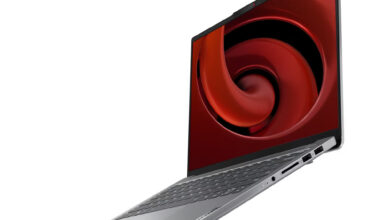
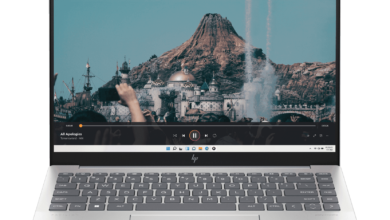
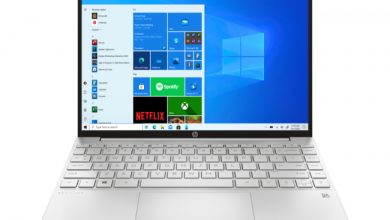
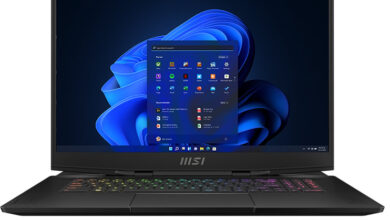
I really like this laptop and I’m thinking about buying it, but I’m worried about one thing and that’s the burn-in effect of this OLED display. Can someone please share their experience with this model or OLED display? Thank you in advance.
The reason for OLED screen burning is that the luminous duration and intensity of the lamp beads in each area of the screen are inconsistent during use, resulting in different degrees of aging between the lamps, so that some lamps become darker, have serious color casts, and some are not serious.
Therefore, on the entire screen, the degree of aging in the areas where certain content is often displayed will be heavier, and the light beads in these areas will be darker than the brightness of other areas. The color shift will also be heavier, just like leaving an imprint, which is what everyone calls screen burning.
Although the OLED screen used in the current market is a relatively new technology, especially the OLED screen used by some first-line manufacturers, the OLED screen with the latest technology is basically used. But the characteristics of OLED are like this, so the OLED screen will burn after a long time.
Another disadvantage of OLED is that the cost of replacing the screen is very high, and it costs 1-2 times more than the cost of the LED screen.